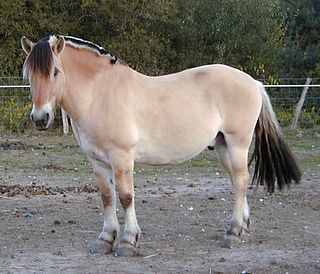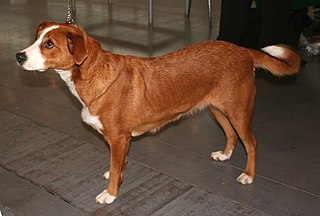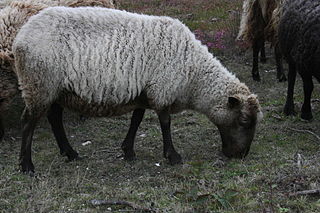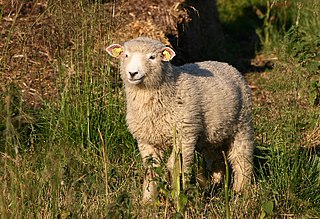
The Ibizan Hound is a lean, agile dog of the hound family. There are two hair types of the breed: smooth and wire. The more commonly seen type is the smooth. Some consider there to be a third type, long, but the longhair is most likely a variation of the wire.

Collies form a distinctive type of herding dogs, including many related landraces and standardized breeds. The type originated in Scotland and Northern England. Collies are medium-sized, fairly lightly-built dogs, with pointed snouts. Many types have a distinctive white color over the shoulders. Collies are very active and agile, and most types of collies have a very strong herding instinct. Collie breeds have spread through many parts of the world, and have diversified into many varieties, sometimes mixed with other dog types.

The Siberian is a centuries-old landrace of domestic cat in Russia, and recently developed as a formal breed with standards promulgated the world over since the late-1980s. Since 2006, the breed is recognised for registry and championship status with all major cat registries.

A landrace is a domesticated, locally adapted, often traditional variety of a species of animal or plant that has developed over time, through adaptation to its natural and cultural environment of agriculture and pastoralism, and due to isolation from other populations of the species. Landraces are distinct from cultivars and from standard breeds.

The Fjord or Norwegian Fjord Horse is a relatively small but very strong horse breed from the mountainous regions of western Norway. It is an agile breed of light draught horse build. It is always dun in colour, with five variations in shade recognised in the breed standard. One of the world's oldest breeds, it has been used for hundreds of years as a farm horse in Norway, and in modern times is popular for its generally good temperament. It is used both as a harness horse and under saddle.

Chinchilla rabbits are a group of three rabbit breeds that have been bred for a coat that resembles that of chinchillas. Despite their name, they are not related to, and cannot interbreed with, chinchillas, a genus of rodent. Rabbits, in contrast, are lagomorphs. A mutation diluted the yellow pigment in the hairs to almost white, changing in this way the color of the fur of the wild type fur (agouti) into chinchilla.

The Gotland Russ or Gotland Pony is an old Swedish breed of pony or small horse. Until the twentieth century it was found only on the small island of Gotland on the south-eastern coast of Sweden. It is now distributed through much of Sweden and is also present in some other European countries and in the United States. The Öland horse from the neighbouring island of Öland was a close relative of the Gotland, but became extinct in the early twentieth century.

The Austrian Pinscher is a medium-sized breed of pinscher-type dog from Austria, where dogs of the type were originally farm dogs, keeping barns free of rats and acting as home guards, livestock guardians, and drovers. The name originally given to the breed in 1928 was the Österreichischer Kurzhaarpinscher to differentiate it from similarly named breeds, but today in its country of origin the breed is officially called the Österreichischer Pinscher, or Austrian Pinscher in English.

Aegean cats are a naturally occurring landrace of domestic cat originating from the Cycladic Islands of Greece and western Turkey. It is considered a natural cat, developing without human interference. Development of the Aegean cat as a formal breed began in the early 1990s by breeders in the fledgling Greek cat fancy, but the variety has yet to be recognized by any major fancier and breeder organization. It is considered to be the only native Greek variety of cat.

The Dutch Landrace is a traditional Dutch breed of domestic goat. It has been known in the Netherlands since the seventeenth century, and was formerly numerous there. It came close to extinction in the 1950s, but was saved by cross-breeding with unrelated goats, and by 2020 numbered over 2000 head.

The Northern European short-tailed sheep are a group of traditional sheep breeds or types found in Northern Europe, mainly in the British Isles, Scandinavia, Iceland, Greenland, and the area around the Baltic. They are thought to be derived from the first sheep brought to Europe by early farmers. They are hardy sheep, adapted to harsh environments, but they are small and have been replaced in most areas with later types of larger, long-tailed sheep.

The Fjäll is a traditional Swedish breed of polled mountain cattle. It was threatened with extinction in the 1970s and 1980s, but recovered after a breed association was formed in 1995, partly thanks to stocks of frozen semen. Microsatellite analysis has shown it to be closely related to the endangered Bohuskulla breed.

The Danish Landrace is a breed of sheep endemic to Jutland in Denmark. The breed, which had a population of approximately 370 in 2000, is not a true landrace, but descend from Heath sheep and Merino, with early specimen interbreeding in the 19th century with Leicester and Oxford Down sheep. While up to 10% of males have horns, the breed is mostly polled.

The New Zealand is a breed of rabbit, which despite the name, is American in origin. The breed originated in California, possibly from rabbits imported from New Zealand. New Zealand rabbits are available in five colors recognized by the American Rabbit Breeders' Association (ARBA): white, red, black, blue, and broken. Crossbreeding can result in many other variations, such as gold tipped steel and chestnut agouti. They average 10–12 lb (4.5–5.4 kg) with the does being slightly larger than the bucks. New Zealands are bred for meat, pelts, show, and laboratory uses, being the most commonly used breed of rabbit both for testing and meat production. They are also bred as pet rabbits but mostly breed for meat.

Nordens Ark is a zoo located on the 383-hectare (950-acre) Åby Manor in Bohuslän, Sweden. Nordens Ark was opened in 1989 and is operated by the Nordens Ark Foundation. Nordens Ark is on the west coast of Sweden, not far from the border with Norway. Victoria, Crown Princess of Sweden, was appointed as Nordens Ark Supreme Protector in 1989.

The Indian pariah dog, also known as the Indian native dog, INDog, Nadan,South Asian pye dog, Desi Kutta, and Neri Kutta, is a landrace of dog native to the Indian subcontinent. They have erect ears, a wedge-shaped head, and a curved tail. It is easily trainable and often used as a guard dog and police dog. This dog is an example of an ancient group of dog known as pye-dogs. There is archaeological evidence that the dog was present in Indian villages as early as 4,500 years ago.

The Mellerud rabbit is a Swedish variety of rabbit of medium size that comes in albino or black with white markings. The Mellerud rabbit has official landrace status in Sweden and is considered a critically endangered variety.

The British primitive goat is a landrace of domestic goat native to Great Britain and Ireland, and is the original goat of the region. It is considered a rare breed, existing as several, isolated feral herds, as some captive populations in zoological parks and nature reserves, and breeding stock on some private farms operated by groups of rare-breed enthusiasts. As few as 1,200 individual British primitives may remain. The variety is also referred to as the British native goat, the old British goat, the old English goat or the British landrace goat, among more specific names It descends from the earliest goats brought to the region in the Neolithic era, around 3,000 BCE. It is classified in the Northern breed group of goats. A population in Northumberland is sometimes referred to as the Cheviot goat. The British primitive is among the foundation stock of some modern standardised breeds, including the Anglo-Nubian goat. The breed is comparatively small, with commensurately low milk production. It is hardy and wiry haired, adapted to rough terrain and weather, and able to subsist and breed on its own without human intervention.

Danish landrace goose, or Danish goose, is a landrace variety of goose native to Denmark.




















